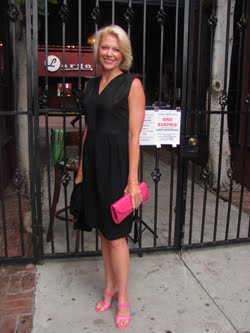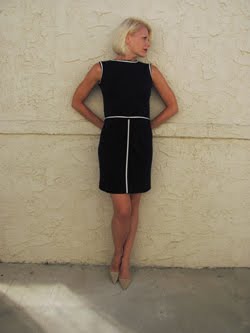After my recent visit to LA's iconic
Union Station, my thoughts have been consumed by all things
film noir. It is, after all, one of my favorite genres and I find myself turning to it again and again for inspiration. We all recognize the hallmarks of
noir. The shadowy and smoky cinematography. The
femme fatale. The questionable moral outlook of the lone searching hero as well as those around him. And, in the best of these films, there are incredible locations and style.
Ridley Scott's direction in
Blade Runner (1982) captures all of these conventions. Though technically
neo noir since it was released more than 30 years beyond the height of
noir in the 1940s, it brings together all the best of the genre to tell its tale. The shadowy and smoky cinematography of Jordan Cronenweth. Sean Young's
femme fatale Rachael. The lone Rick Deckard (Harrison Ford), a former LAPD detective who had killing as part of his job description. A former partner (Edward James Olmos) and Chief of Police (M. Emmett Walsh) who want him to do it once again. And the production design of Lawrence G. Paull, who drew inspiration from Fritz Lang's
Metropolis (1927) and included numerous historic downtown Los Angeles locations.
Film noir favorites Union Station, the Bradbury Building, Pan American Building, Bonaventure Hotel, and 2nd Street tunnel all act as part of the picture along with Frank Lloyd Wright's 1924 architectural masterpiece, the
Ennis House. Also
Blade Runner is partially set in Chinatown, such an iconic location that Roman Polanski even named his own
neo noir after it.
Adding to the drama of the film is the costume design of Charles Knode and Michael Kaplan. Their style is a study in both 1930s and 1940s dressing. Coats with face-framing collars--many made of fur--are reminiscent of those Myrna Loy wore in the 1930s
noir Thin Man movies. Sean's suits are pure 1940s and evoke Joan Crawford's strong sharp shoulders, especially in her Oscar-winning
noir Mildred Pierce. Combined with the fitted suits, rolled and smoothly set hair, and matching red nails and lips, you get a pitch-perfect wardrobe for Rachael.
There are many deep themes that run throughout
Blade Runner and even more in the book (
Do Androids Dream of Electric Sleep?) on which the movie is based. Set in 2019, it is a time when humans can be bioengineered and are used for slave labor and prostitution. Because these replicants sense their own humanity, they begin to fight for their rights and long for an extension of their short lives. Their often violent revolt has made them illegal on Earth and blade runners like Deckard are hired to hunt and "retire" them. All of this draws interesting moral and ethical questions, including the numerous qualities that make up a "human" and the Kantian assertion that you cannot use a person as a means to an end.
This philosophical foundation helps give
Blade Runner staying power, but its
style is what has really made such a social impact. The style is, without question, a huge reason the picture has progressed from cult favorite to classic and now counted as one of AFI's "Best of All Time." Proving that the classics never go out of fashion, there may be more 1940s style to savor in this picture than in many other
film noir combined. And it also offers us inspiration on how to flawlessly integrate classic style into our (futuristic) lives today. So let's count the ways...in
Blade Runner.
The movies starts with all the hallmarks of film noir--
ceiling fan, detective smoking in a hazy room, steel steamer desks
But this story takes place in 2019...the Los Angeles skyline is different,
including the pyramid skyscraper for the Tyrell Corporation
Chinatown, an iconic location for film noir
Our first glimpse at our hero Rick Deckard dressed in a trenchcoat, the uniform of any great detective
Landing at the police station to see Deckard's former boss, Chief Bryant...at LA's
Union StationThe whole police station is set like an older movie with
the blinds, lamps, silver framed photos, drinks on the desk, and devious detectives--
former partner Gaff (Edward James Olmos, above) and hard drinking Chief (M. Emmett Walsh)
Deckard's been given a nasty assignment to once again "retire" a group of replicants back on earth...
first stop is to see Dr. Eldon Tyrell, CEO of Tyrell Corp. and creator of replicants
There Deckard meets Rachael (Sean Young), who is dressed in the epitome of 40s suiting--
strong shoulders and fitted silk jacket, slim pencil skirt, and rolled 40s hair do with orange-red lips
Deckard interviews Rachael and determines that she, too, is a replicant
who believes herself to be human
The cinematography matches the best of film noir
Taking the 2nd Street tunnel to head home in Deckard's version of the beat up car
Deckard arrives at his apartment--set within Frank Lloyd Wright's Ennis House--and
Rachael surprises with a visit in her 1930s quilted navy coat with black fur collar
The bad guys--replicants Roy (Rutger Hauer), Leon (Brion James), and
"pleasure model" Pris (Darryl Hannah)
Deckard can't help but think about Rachael and tries calling...
she refuses to see him but later joins him in a glamorous fur coat at his apartment
Another sharp 40s suit in shades of gray that screams of Joan Crawford
Both Deckard and Rachael are dealing with feelings for one another
Photographs equate to memories in a human's existence and Rachael longs to have her own
In an effort to seem more human, Rachael messes up her perfect hair and takes off her coat
to reveal a much softer silk charmeuse blouse...all of which Deckard cannot resist
More signs of noir--the "Yukon Hotel" is downtown LA's Pan American Building
and of course the all-American iconography of the Coca-Cola logo
Deckard pulls up at two more LA landmarks--
the Bradbury Building and the Million Dollar Theater--in downtown LA
Inside the Bradbury and through the ceiling we see another reminder of Chinatown
Finishing business at the Bradbury (above)
and more possible trouble back at home
Former partner Gaff has threatened to kill Rachael since Deckard won't do it,
so the couple must try to escape together
Sign that Gaff (Olmos) has been there and let them go

















































































































































